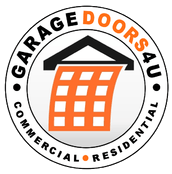A safe process for garage door spring repair requires knowledge, the right tools, and a commitment to safety. A broken garage door spring or opener spring might interfere with your everyday schedule and compromise the safety of your house. The root cause is often a damaged or broken spring—a crucial component supporting the door’s heavy lifting.
In this guide, we’ll explore practical tips and expert advice to help you handle these repairs, ensuring your garage door operates smoothly again.
Understanding Garage Door Springs
The main garage door springs: torsion springs and extension springs. Each type has unique characteristics and safety concerns:
- Torsion Springs: These are located above the garage door and operate by twisting to generate torque. They’re known for their durability and efficiency.
- Extension Springs: These stretch as the garage door is lowered, storing energy to raise it again. On either side of the door are these springs.
Both types can pose serious risks when mishandled, as they are under significant tension.
Tips for Safely Handling Garage Door Spring Repair
1. Recognize When a Spring Is Broken
Before attempting any garage door spring repair, identify whether the spring is broken. Common signs include:
- The garage door feels unusually heavy.
- The door doesn’t open evenly.
- Visible gaps in the spring.
- The motor is under too much strain because the garage door opener spring broken.
If you notice these signs, stop using the door immediately to prevent further damage.
2. Gather the Right Tools and Safety Gear
Repairing or replacing springs requires specific tools and safety precautions. Here’s what you need:
- Safety goggles and gloves help you protect against debris or accidental contact.
- Winding bars (for torsion springs) to safely release tension.
- Clamps to secure the door in place.
- A sturdy ladder to access the springs.
3. Release Tension Carefully
Releasing stress is a crucial step for spring torsion. Follow these guidelines:
- To avoid unintentional activation, disconnect the garage door opener.
- Use winding bars to adjust the spring tension. Never use improvised tools like screwdrivers, as they can slip.
- Work slowly and steadily to avoid sudden releases of energy.
To stop an extension spring from dropping, make sure the garage door is completely open and fastened with clamps or locking pliers.
4. Handle Torsion Spring Repair or Replacement with Precision
First, check your garage door springs need to be replaced or repaired. Replacing or repairing a torsion spring involves precise measurements and adjustments:
- Measure the spring’s length, diameter, and wire size to ensure you purchase the correct replacement.
- Install the new spring by securing it to the torsion bar and gradually winding it to the recommended number of turns.
- Test the door’s balance after installation. If it doesn’t stay in place when it is halfway open, additional adjustments may be needed.
5. Replace or Repair Extension Springs in Pairs
Extension springs should always be replaced in pairs, even if only one spring appears damaged. This guarantees equal stress on the door’s two sides, avoiding uneven wear and other problems.
Check for Related Issues
While fixing garage door springs, inspect other components for damage:
- Broken Garage Door Cables: These often occur alongside spring issues. Replace broken garage door cables or snapped cables to restore safe operation.
- Garage Door Opener Repair: A strained opener motor could indicate spring problems. Address the spring issue first, then test the opener for smooth operation after the garage door opener repair.
Test the Door’s Functionality
After completing a replacement or repair, test the door by opening and closing it manually. The door should move smoothly and stay balanced in various positions. Reconnect the garage door opener and ensure it operates without Strain.
6. Know When to Call a Professional
While DIY repairs can be cost-effective, some situations require professional assistance:
- Lack of experience or proper tools.
- Complex issues like a misaligned garage door or damaged tracks.
- High-tension torsion spring replacement poses significant safety risks.
Contacting a qualified technician ensures the garage door spring repair is done safely and correctly. If your garage door springs are completely damaged, contact Garage Door Repair Loveland Co for accurate and professional service.
Preventive Maintenance Tips For Torsion and Extension Springs
To extend the lifespan of your garage door springs and avoid frequent repairs, consider these tips:
- Lubricate the Springs: Apply a silicone-based lubricant to reduce friction and prevent rust.
- Inspect Regularly: Check for wear and tear, such as rust, cracks, or stretched coils.
- Balance the Door: To identify issues early, test the door’s balance periodically.
- Limit Strain on the Opener: Avoid using the garage door opener excessively to reduce wear on the springs and motor.
We hope you now understand the critical aspects of garage door spring repair and the importance of safety. By following these tips or consulting Garage Door Repair Loveland CO, you can ensure your garage door operates good for years to come.
FAQ’s
Q1: How do I know if I need a torsion or extension spring replacement?
Ans: Identify the type of spring your garage door uses. Torsion springs are above the door and extension garage door springs run along the sides. If the spring is broken, you may notice a gap in the coils or difficulty operating the door. Always consult a professional if unsure.
Q2: Can I fix garage door spring issues without professional help?
Ans: While it’s possible to fix garage door spring yourself, it’s not recommended unless you have experience and proper tools. The high tension in springs can cause severe injury if mishandled. Hiring a professional ensures safety and quality.
Q3: What should I do if I notice broken garage door cables?
Ans: Broken cables often occur alongside spring damage. Replacing the cables and addressing spring issues simultaneously ensures the door operates smoothly. Secure the door to prevent it from falling, and consult a technician if needed.

